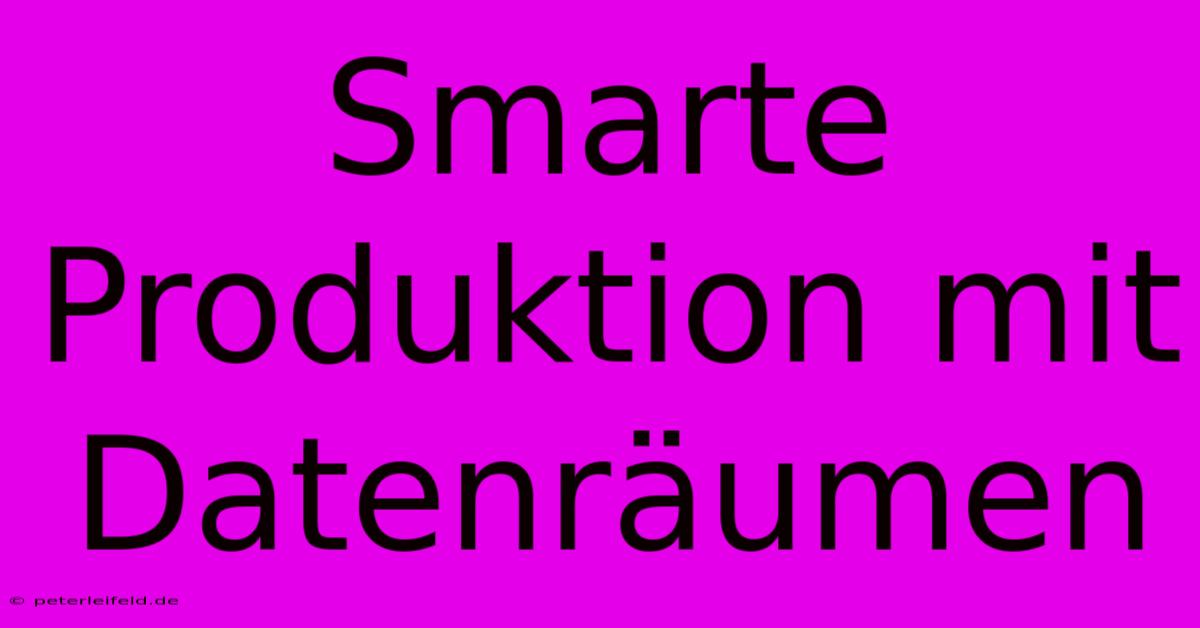Smarte Produktion Mit Datenräumen

Discover more detailed and exciting information on our website. Click the link below to start your adventure: Visit Best Website Smarte Produktion Mit Datenräumen. Don't miss out!
Table of Contents
Smarte Produktion mit Datenräumen: Meine Erfahrungen und Tipps
Hey Leute! Let's talk about smarte Produktion – specifically, how Datenräume can totally revolutionize things. I've been knee-deep in this stuff for years, and lemme tell ya, it's been a wild ride. Lots of breakthroughs, but also some epic fails along the way. Think of this as a friendly chat, not a stuffy lecture.
Early Days: Chaos and Confusion
Remember when I first started working with Datenräume in der Produktion? Total chaos! We had data everywhere, but no clear way to access or analyze it. It was like trying to find a needle in a digital haystack – a massive haystack. We were drowning in information but starving for insights. It was frustrating AF.
One time, we were trying to optimize our production line using data from different machines. Sounds simple, right? Wrong. The data formats were all different – some were CSV, others were XML, you name it. It took weeks just to get the data into a usable format. Seriously, weeks! We were losing money hand over fist. The project almost got scrapped.
Lesson Learned #1: Data Standardization is Key
This experience taught me a HUGE lesson: Datenstandardisierung is not optional; it's absolutely essential. Before you even think about building a Datenraum, you need a clear plan for how you'll handle data formats. Choose a standard and stick to it. It'll save you weeks, maybe even months, of frustration. Believe me, it's worth the effort.
Building Our Datenraum: A Step-by-Step Approach
After that initial disaster, we took a more structured approach. We started by defining our goals – what did we want to achieve with our Datenraum? Better Produktionsoptimierung? Reduced downtime? Improved quality control? Once we had clear goals, we could choose the right tools and technologies.
We ended up using a combination of cloud-based platforms and on-premise solutions. It wasn't a simple process; it took a lot of trial and error. I even had some arguments with my team about which tech to use. It was a bit of a struggle, but in the end, we were able to create a scalable solution that met our needs.
Lesson Learned #2: Start Small, Think Big
Don't try to boil the ocean. Start with a small, well-defined pilot project. This will help you to test your tools and processes, and identify any potential problems before you invest heavily in a full-scale deployment. Trust me on this one, a smaller project is easier to manage.
The Benefits of a Well-Structured Datenraum
After all the struggles, seeing the results was insanely rewarding. Our Datenraum provided us with real-time visibility into our production process. We could identify bottlenecks, optimize resource allocation, and improve quality control – all thanks to the data.
We also saw significant improvements in Effizienz and reduced waste. Our data analysis helped to predict potential issues before they occurred, allowing us to take proactive measures. It even reduced our production costs by more than 15% in the first year! That's a serious win.
Lesson Learned #3: Data Visualization is Crucial
Don't just collect data; visualize it! Use dashboards and reports to make your data easily accessible and understandable. This will help you to identify trends, patterns, and anomalies that might otherwise go unnoticed.
The Future of Smarte Produktion with Datenräume
The use of Datenräume in Industrie 4.0 is just getting started. As technology continues to evolve, the possibilities are endless. I’m excited to see what happens next. The potential for improving efficiency, reducing costs, and enhancing quality is huge. But remember, it's not a magic bullet. It takes planning, dedication, and a willingness to learn from your mistakes. Just like I did. Good luck! You got this.

Thank you for visiting our website wich cover about Smarte Produktion Mit Datenräumen. We hope the information provided has been useful to you. Feel free to contact us if you have any questions or need further assistance. See you next time and dont miss to bookmark.
Featured Posts
-
Adani Skandal Erschuettert Indien
Nov 21, 2024
-
Indiana Jones Pc Angebot Geizhals Limit
Nov 21, 2024
-
Cybersicherheit Gemeinsam Meistern
Nov 21, 2024
-
Meinl Reisinger Todesangst Gestorben
Nov 21, 2024
-
Rechtsterrorist Breivik Haft Bleibt Bestehen
Nov 21, 2024
